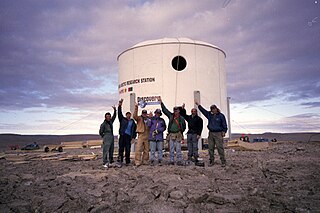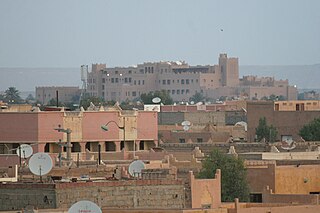
A space suit or spacesuit is a garment worn to keep a human alive in the harsh environment of outer space, vacuum and temperature extremes. Space suits are often worn inside spacecraft as a safety precaution in case of loss of cabin pressure, and are necessary for extravehicular activity (EVA), work done outside spacecraft. Space suits have been worn for such work in Earth orbit, on the surface of the Moon, and en route back to Earth from the Moon. Modern space suits augment the basic pressure garment with a complex system of equipment and environmental systems designed to keep the wearer comfortable, and to minimize the effort required to bend the limbs, resisting a soft pressure garment's natural tendency to stiffen against the vacuum. A self-contained oxygen supply and environmental control system is frequently employed to allow complete freedom of movement, independent of the spacecraft.

Aerobraking is a spaceflight maneuver that reduces the high point of an elliptical orbit (apoapsis) by flying the vehicle through the atmosphere at the low point of the orbit (periapsis). The resulting drag slows the spacecraft. Aerobraking is used when a spacecraft requires a low orbit after arriving at a body with an atmosphere, as it requires less fuel than using propulsion to slow down.

The Mars Desert Research Station (MDRS) is the largest and longest-running Mars surface research facility and is one of two simulated Mars analog habitats owned and operated by the Mars Society.

The Constellation program was a crewed spaceflight program developed by NASA, the space agency of the United States, from 2005 to 2009. The major goals of the program were "completion of the International Space Station" and a "return to the Moon no later than 2020" with a crewed flight to the planet Mars as the ultimate goal. The program's logo reflected the three stages of the program: the Earth (ISS), the Moon, and finally Mars—while the Mars goal also found expression in the name given to the program's booster rockets: Ares. The technological aims of the program included the regaining of significant astronaut experience beyond low Earth orbit and the development of technologies necessary to enable sustained human presence on other planetary bodies.

The Vision for Space Exploration (VSE) was a plan for space exploration announced on January 14, 2004 by President George W. Bush. It was conceived as a response to the Space Shuttle Columbia disaster, the state of human spaceflight at NASA, and as a way to regain public enthusiasm for space exploration.

The Flashline Mars Arctic Research Station (FMARS) is the first of two simulated Mars habitats located on Devon Island, Nunavut, Canada, which is owned and operated by the Mars Society. The station is a member of the European Union-INTERACT circumarctic network of currently 89 terrestrial field bases located in northern Europe, Russia, US, Canada, Greenland, Iceland, the Faroe Islands, and Scotland as well as stations in northern alpine areas.

Erfoud is an oasis town in the Sahara Desert, in the Drâa-Tafilalet region, eastern Morocco. It belongs to ait atta tribe, divided into several districts: Hay Salam, Hay Jdid, Hay Ziz, Hay el Bathaa, Hay Annahda, and Hay el Hamri.
SpaceWorks Enterprises, Inc. (SEI) is an aerospace engineering company based in Atlanta, Georgia, United States that specializes in the design, assessment, hardware prototyping and flight demonstration of advanced space concepts for both government and commercial customers.
Human analog missions are activities undertaken on Earth in various environments to simulate aspects of human missions to other worlds, including the Moon, asteroids, and Mars. These remote field tests are performed in locations that are identified based on their physical similarities to the extreme space environments of a target mission. Such activities are undertaken to test hardware and operational concepts in relevant environments.
Terrestrial analogue sites are places on Earth with assumed past or present geological, environmental or biological conditions of a celestial body such as the Moon or Mars. Analogue sites are used in the frame of space exploration to either study geological or biological processes observed on other planets, or to prepare astronauts for surface extra-vehicular activity.
Aouda is a character in a novel by Jules Verne.

The Hawaii Space Exploration Analog and Simulation (HI-SEAS) is an analog habitat for human spaceflight to Mars currently operated by the International MoonBase Alliance. HI-SEAS is located in an isolated position on the slopes of the Mauna Loa volcano on the island of Hawaii. The area has Mars-like features and an elevation of approximately 8,200 feet (2,500 m) above sea level. The first HI-SEAS study was in 2013 and NASA's Human Research Program continues to fund and sponsor follow-up studies. The missions are of extended duration from four months to a year. Its missions place HI-SEAS in the company of a small group of analogs that are capable of operating very long duration missions in isolated and confined environments, such as Mars500, Concordia, and the International Space Station.
A Mars analog habitat is one of several historical, existing or proposed research stations designed to simulate the physical and psychological environment of a Martian exploration mission. These habitats are used to study the equipment and techniques that will be used to analyze the surface of Mars during a future crewed mission, and the simulated isolation of the volunteer inhabitants allows scientists to study the medical and psychosocial effects of long-term space missions. They are often constructed in support of extensive Mars analogs. However, sometimes existing natural places are also valued as Mars analogs. Crewed Mars habitats are featured in most human Mars missions; an alternative may be terraforming or telepresence.
Mars Orbiter Mission 2, is a proposed second mission to Mars by the Indian Space Research Organisation (ISRO). In a recorded interview in October 2019, the Vikram Sarabhai Space Centre (VSSC) director indicated the possibility of inclusion of a lander, but in an interview to The Times Of India in February 2021 the ISRO chairman clarified that the mission will consist solely of an orbiter. The orbiter will use aerobraking to lower its initial apoapsis and enter into an orbit more suitable for observations.
The Tera-hertz Explorer (TEREX) mission is a planned orbiter and lander that will be carrying a terahertz sensor to the surface of Mars to measure the oxygen isotope ratios of various molecules in the Martian atmosphere. The objective of the mission is to understand the chain of chemical reactions that resupply the atmosphere with carbon dioxide.
The International Lunar Exploration Working Group(ILEWG) is a public forum sponsored by the world's space agencies to support "international cooperation towards a world strategy for the exploration and utilization of the Moon - our natural satellite" (International Lunar Workshop, Beatenberg (CH), June 1994).

D-MARS is a human analog mission to the planet Mars, taking place in Makhtesh Ramon in the Negev desert in Israel. D-MARS is an acronym for "Desert Mars Analog Ramon Station" and its crew are known as "ramonauts". Ramon's geological features and aridity are similar to those of Mars. The mission site is a valley that resembles the impact craters of Mars.

A space habitat in a basic sense is any facility fulfilling habitational purposes in outer space. It is not to be confused with an extended space habitat, an arrangement of or infrastructure for multiple habitation facilities, in the sense of a space settlement. Space stations or theoretical extraterrestrial stations, such as a Moonbase or Mars habitat, include or are basic space habitats.
Astroland Interplanetary Agency is a Spanish interplanetary agency based in Cantabria, Spain. Astroland operates the first permanent, plug-and -play subsurface analogue station inside a cave of 1.5 km long and 60 meters high in Santander. Astroland is an aerospace startup acting as a research organization, whose main objective is to envision future living capabilities on Mars.










